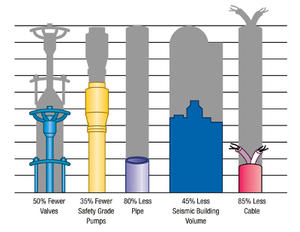Nuclear mattersNew reactor design lessens risks
One of the major vulnerabilities of the four Japanese reactors which failed as a result of the combined force of the earthquake and tsunami, was that they relied on active cooling systems that require electricity; if there is a power outage, and if diesel back-up generators stop working, water stops flowing into the reactor pool to keep the uranium rods cool; newer reactor design relies on a passive cooling system: water is suspended over the reactor housing, and if pressure within the system drops, this allows the water to fall into the reactor area, submerging it in enough water to keep it cool

New design reduces points of failure // Source: westinghousenuclear.com
Experts say that one reason four nuclear reactors in Japan failed as a result of the 8.9 earthquake – which was followed by an even more devastating tsunami – is that they are old. The latest nuclear reactor designs could help avoid the overheating and explosions that have occurred at the Fukushima Daiichi nuclear plant,
Among the features of newer reactor designs is the use of passive cooling systems that would not fail after a power outage, as happened in Japan, as well as other novel approaches to managing reactor heat. Technology Review reports that the reactors at the Japanese nuclear plant, built in the early 1970s, rely on active cooling systems that require electricity. Newer plant designs would lessen or eliminate the need for active cooling, making use of natural convection or a “gravity feed” system to cool reactors in the event of an emergency.
TR notes that in one design, for example, the relatively new Westinghouse AP1000, water is suspended over the reactor housing. If pressure within the system drops, this allows the water to fall into the reactor area, submerging it in enough water to keep it cool.
The passive systems could be better in the event of electrical failures, but they might not always be the safest systems. Andrew Kadak, a research affiliate at MIT, told TR that in an active system, it is easier to ensure that coolant gets exactly where it needs to be – it is simply pumped to the right location. Designing passive systems, on the other hand, requires complex models of how fluids will behave in a system that could be rendered incorrect if the system is damaged.
Kadak says that even more advanced reactor designs could overcome these issues. Some advanced reactors use molten metals to cool the reactor — the mass of these systems is enough to provide cooling in an emergency, he says, although if the molten metal were displaced by an earthquake, that could be a problem of its own. TR writes that Kadak has devoted much of his career to another advanced alternative, the “pebble bed reactor,” which is designed to make it impossible for the fuel to get hot enough for a meltdown. The tradeoff is that the reactors, which are the same size as conventional ones, produce only about 1/10th as much power.
